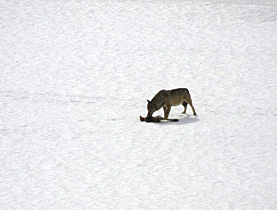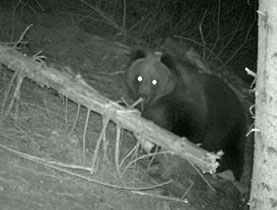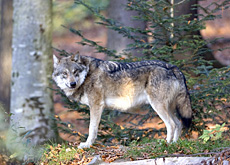Living with the big bad alpine wolf

Recent wolf attacks on sheep have once again highlighted the sensitive issue of co-existence with the protected predator.
The number of wolves in Switzerland is expected to rise in the coming years. Yet critics of the current protection strategy say the wolf remains a taboo subject and greater transparency, monitoring and prevention is needed.
Since mid-May over 100 sheep have been slaughtered by wolves in cantons Valais, Bern, Fribourg and Lucerne. The Valais and Lucerne authorities this week said three wolves involved in these incidents could be shot.
Fifteen sheep were killed in an attack in the Dix Valley in canton Valais last weekend. The flock was in an enclosure and watched over by two mountain dogs and a donkey.
“We have a feeling of powerlessness,” Arthur Vuissoz, owner of the herd, told swissinfo.ch. “No one suspected that there was a wolf in the area. We took all the preventive measures and it still attacks. It’s hard to know what we can improve.”
“I’m sure we’ll be attacked over the coming days,” he added.
Rising numbers
Wolves were driven out of Switzerland in the 19th century. They started to return about ten years ago from neighbouring Italy and have begun colonising again.
According to experts, there are around 200 wolves in the Alps, of which 150 live in France and 40 in Italy. In Switzerland seven wolves have been confirmed by DNA analysis, but it is thought there may be up to 20 – and the number is likely to rise.
Graubünden, in eastern Switzerland, is one of the areas – along with Valais and Ticino – which has been most affected by the wolf’s return. But since last year the alpine predator, which can travel up to 50 kilometres a day, has started migrating to cantons Vaud, Fribourg, Lucerne and Bern.
“They haven’t yet reached the St Gallen or Jura mountains but they represent a suitable habitat. They will be the next areas wolves will move into,” said Reinhard Schnidrig, head of the wildlife and forest biodiversity section at the Federal Environment Office.
Greater transparency
According to a recent poll, the wolf is enjoying a wave of national support. Some 87 per cent of those questioned by the animal association zooschweiz in May said they backed a natural return of the wolf, up from 57 per cent in 1997.
But periodic attacks on livestock and growth in numbers are causing alarm among certain farmers and mountain communities.
“I don’t think it’s possible to cohabit with the wolf,” said Vuissoz. “We have mountain pastures that need maintaining and there’s not enough space.”
Roland Gex, president of Vérossaz commune in canton Valais, which witnessed recent attacks, calls for greater transparency by the federal and cantonal authorities.
“According to the Swiss Wolf Project, the number of wolves will progress 20-30 per cent per year,” he said.
“The population wants to know if there are five wolves in the region and ten next year, and how we are going to manage and pay for that. There is a total lack of transparency. We want the truth.”
Taboo
Wolf expert Jean-Marc Landry agreed that national monitoring of packs and young cubs could be improved.
“We don’t really know what’s happening. We have suspicions but don’t really have the proof,” he said. “We should work closer with the French and Italians, and democratise the wolf.”
He added that more resources should go into prevention, research into the effectiveness and aggressiveness of mountain dogs, and training and information on wolves for farmers.
“The wolf is a taboo subject. You have the impression that politicians are scared when people talk about wolves,” he said. “
On Wednesday WWF Switzerland also called for stronger protection measures and a more efficient reimbursement scheme for sheep farmers.
But Schnidrig said the wolf protection programme and prevention system was working “quite well”.
“As soon as we have results about the genetic analysis of a wolf you can find them on our website and whenever we have results we send them to the cantons and regions where wolves live,” he said. “We try to tell people to watch out for wolves in their region so they protect their sheep.”
“We have many examples that prove that dogs, shepherds, herding sheep at night and fences together can reduce the number of killings to just a few or to zero,” he declared.
“Most times the sheep owners don’t do anything until they have dead sheep….[but] even with the best prevention measures we can’t promise zero risk.”
Simon Bradley, swissinfo.ch
Wolves gained “strictly protected” status in Europe under an international agreement after being driven to extinction in the 19th century, largely by hunting and the expansion of human settlements. They started to return to Switzerland about ten years ago from neighbouring Italy and have begun colonising again.
Their diet mostly includes stags (30%), deer (21%), goats (12%), sheep (12%), ibex, chamois and wild boar (5%) and cattle (2.5%). They generally live high up in the mountains and don’t attack sheep if they have other things to eat and if the sheep are protected by guard dogs.
The government’s “Swiss Wolf Project” was drawn up in 2001, with revisions later added permitting the shooting of any wolf believed to have killed at least 35 sheep over a four-month period, or 25 in a single month.
Since 2000 official cantonal authorisation to kill a wolf has been given seven times and five have been shot dead. The penalty for illegally killing a wolf is up to one year in prison and a fine.

In compliance with the JTI standards
More: SWI swissinfo.ch certified by the Journalism Trust Initiative












You can find an overview of ongoing debates with our journalists here . Please join us!
If you want to start a conversation about a topic raised in this article or want to report factual errors, email us at english@swissinfo.ch.